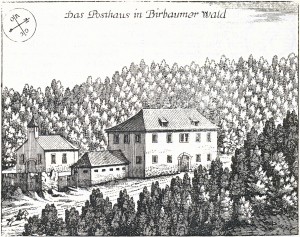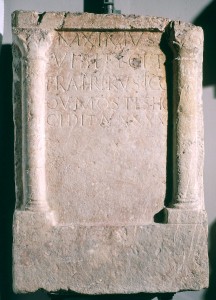Crime in these regions took various forms. A Roman tombstone was discovered more than a century ago near Škofljica, not far from Ljubljana, most likely at the place where it had originally stood, some 12 km southeast of Emona. Unfortunately, its surface is so badly corroded that not even the name of the deceased young man can be read with certainty; however, there is no doubt that he was murdered. He was eighteen years old and was probably called Paetinius Clementinianus; according to the inscription, he was killed in a stable. It was his brother Paetinius (?) Peregrinus who erected the tombstone to him, as well as to their mother Caesernia (?) Galla. She must have died earlier, but there is no mention of their father. The word ‘stable’ in this context probably means a tavern with a stable, where travellers who arrived with their horses could spend the night.
We shall never know why Clementinianus was killed. This was certainly not an accident, since it is expressly stated that he was killed in a criminal way. The murder could have happened in the tavern in the settlement where he lived, unless he was killed while on a journey, in some distant inn. He probably lived in the road settlement near Škofljica, since he is commemorated on the family tombstone. His death may have been due to robbery or to some kind of revenge or else he may have been involved in illegal activity.
Clementinianus’ funerary inscription reminds us of another one found at Fluvio Frigido/Castra (Ajdovščina), an important settlement on the way from Emona to Aquileia. The tombstone commemorates one Antonius Valentinus, a commander (centurion) in the 13th legion Gemina, who was killed by robbers in the Julian Alps, at Scelerata, that is at a place called ‘Accursed’. A site with such a name implies that crimes often occurred in that area. The funerary monument was erected to Valentinus by his son of the same name.
A traveller going from Fluvio Frigido towards Emona soon began to ascend, reaching the highest point of the road at Ad Pirum (Hrušica), the famous pass in the Julian Alps. The place must have looked magnificent, deeply impressing all those traveling across it. It was surrounded by rocks, hills, and impenetrable forests inhabited by wolves and bears; it was very easy to get lost there. This was a military route constructed by the emperor Augustus as the shortest communication route between Aquileia and Emona. Travel along it could be dangerous; there were plenty of hiding places for robbers, who could easily attack a small caravan or a single traveller. Undoubtedly, they did so often.
Actually, there were so many brigands in the nearby province of Dalmatia and in the more distant Moesia (modern Serbia and Kosovo) that the emperor Marcus Aurelius forcibly recruited them into the Roman army. That happened at the time of the Marcomannic Wars (167–180 AD), when the Empire was seriously endangered by attacks of several German and Sarmatian peoples. Indeed, the enemy even crossed the borders, notably the Danube, penetrating not only into the provinces of Noricum and Pannonia, but even into Italy. The Marcomanni and Quadi came as far as Verona, besieged Aquileia and destroyed Opitergium (Oderzo).
It may have been during such an attack that an inhabitant of Ig at the outskirts of Emona was killed by an enemy. His tombstone (whose Latin text is reported above) reads: ‘Maximus, son of Vib(i)us, had the tombstone erected to his brother Rusticus, killed by the enemy when he was forty years old’. Maximus’ knowledge of Latin was poor, as indicated by three mistakes in the inscription. Instead of ‘quem hostis occidit’ (whom the enemy killed), the stone-cutter carved ‘quem ostes hoccidit’. Probably local people were still speaking their own language; however, they knew enough Latin to use it for their funerary inscriptions, communicating to the others their distress about the crime that had happened in their community.



